The End Of An Era – An Emotional Day
EDITOR’S NOTE:As I learned only five days later, this would, in fact, not be the last freight train to the Planters Rice Mill. That happened on the 20th, and I was fortunate enough to chase and voluminously document the return trip the next day. However, this website is, above all other things that it is, a personal blog, and the text narrative that accompanies the images reflects my thinking at the time, including the assumption that this was the last train to the mill, an assumption that was based from inferences of evidence from various sources at the time; so, this paragraph, this note, this disclaimer, is the only acknowledgement in this long post that, contrary to what I wrote here, this was, in fact, not the last train to the Planters Rice Mill in Abbeville.
How It Ends, Part 2
So, it is happening. Today, the last train from the Planters Rice Mill in Abbeville, Louisiana, ran, as the Louisiana & Delta Railroad moved the last railroad shipments from the mill, today, Wednesday 15 April 2020.
Yesterday, the LDRR 1710 and four L&D trainmen came to town with two empty hopper cars and a loaded tank car for Coastal Chemical, pulled the three loaded cars at the mill, and spotted the two empty cars at the mill before tying down the locomotive and the four loaded cars in the runaround track, and I got many photographs of all of this.
So, I figured that, as early as today, the two empty cars at the mill would be loaded, and a crew would come to pull them and bring the five hopper cars back to New Iberia, stopping at Coastal Chemical to set out the tank car, and that is what happened.
Today was an emotional day, after the emotional day that yesterday was. I was so tired, so drained, from all of the action yesterday, that I fell asleep without having taken shower, which wasn’t all that bad considering that the weather yesterday was pleasantly cool, and I didn’t get sweaty.
Because I wanted to take as much advantage of the morning light as I could to not only take advantage of the rare occasion of morning light on a locomotive in downtown Abbeville (because railroad action here almost never happens in the morning) but also to do that on the occasion of the last run, I didn’t take a shower in the morning either; I hurried as fast as I could downtown to get some shots of not only the parked locomotive and cars but also the last two cars being loaded.
By 09:21 CDT, already a bit too late to get the good early-morning light, I arrived and started taking pictures.

At left are the rice mill, the two hopper cars that the L&D brought to town yesterday, and men loading them.

At right are the LDRR 1710, which brought those two cars at the mill to the mill yesterday, the three cars that it pulled yesterday from the mill, and the tank car with which it arrived in town yesterday, to be set out at Coastal Chemical on the way back to New Iberia today.

One of the problems that I’d have faced had I come here earlier is that, even though the lighting would have been better, there is bad graffiti on the northern side of one of those hopper cars at right. That’s part of why I am disappointed that a separate run won’t be made for these last two cars at the mill, because that would have been, as the train yesterday was, a very photographable train.

Here, the remaining mill employees are loading the UP 93804.
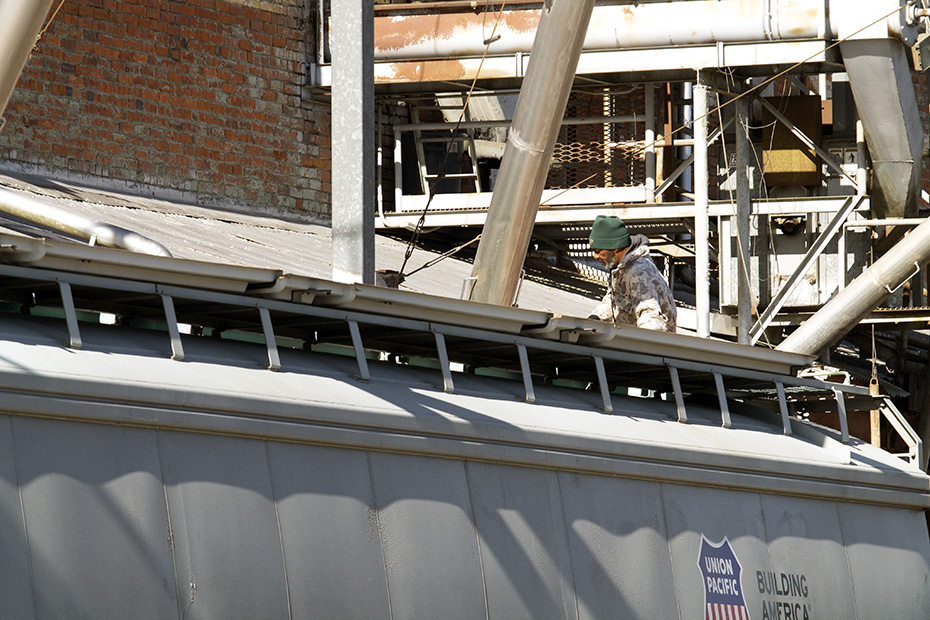
Another advantage of arriving here this late in the morning is that I’m here when the sunlight is crossing over to the southern side of the train.

I like these views, even if the lighting is not perfect. It’s still good.

Tillie Caileff died yesterday, and now this railroad branch is dying.

Imagine how this place would have looked – and functioned – 50 years ago, 75 years ago, or 100 years ago.

Supposedly, Kennedy has already gutted the rice mill of some of the equipment that he installed in the place, meaning that, if anyone is going to restart the place, it will take probably a million dollars worth of investment, decreasing the likelihood that anyone will do anything with it.
That makes me sad.

It makes a great many other people around here, too, sad.
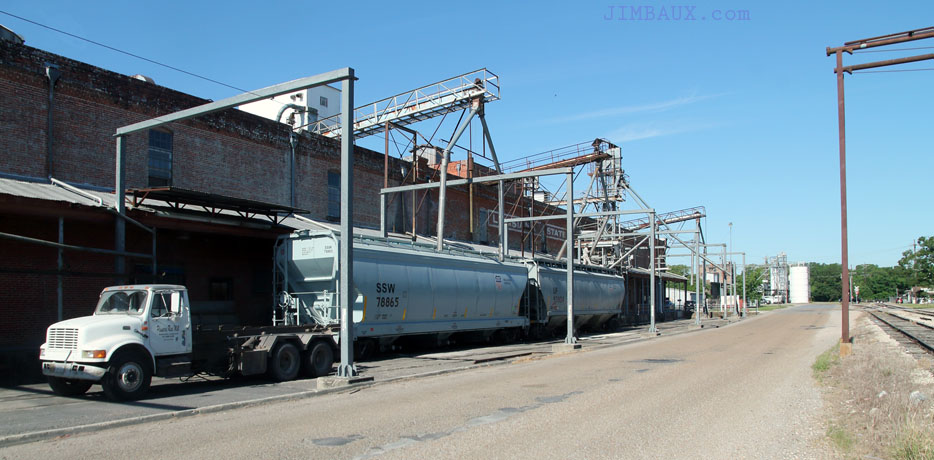
So, the tractor truck here is something that the mill uses to move the railroad cars among the loading chutes.

The UP 93804 is still being loaded.

I don’t think that I had ever photographed the cars being loaded before, at least not in this detail and in this scope, but I figured that doing so was really important now!

The lighting here is really tricky, though, as this is the northern side of the mill, and I had to do some serious work in Adobe Photoshop to get these images looking decent.

Although I’d rather see cars with big “SOUTHERN PACIFIC” or “COTTON BELT” lettering on the sides, I am pleased that these last two cars at the mill are free of any obvious graffiti (even if they have a tiny bit of it.)

One year ago just a few days from now, I photographed, in a crazy driving rain, a railroad run here that was a healthy size in both directions. It’s a shame that, a year later, the mill is closing.

Change is happening, as work is happening in the lot to the left, where a structure that had been a grocery store many years ago was recently dismantled.

This is South Jefferson Street.
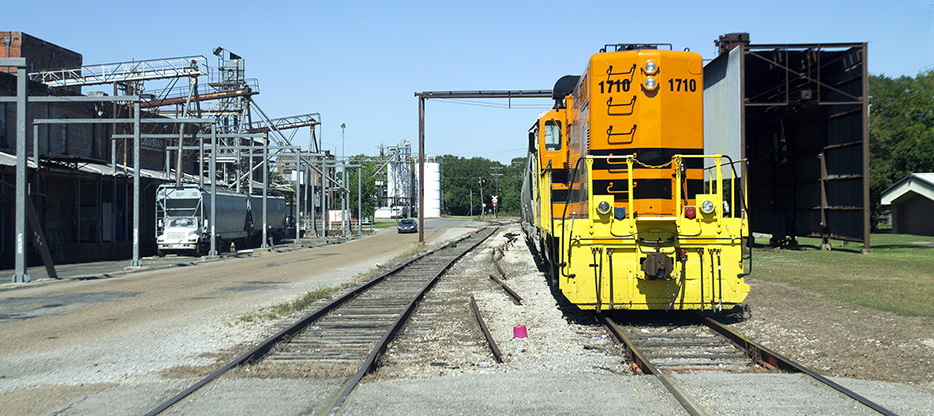
It looks like the UP 93804 has been loaded, and, now, the SSW 78865 will be loaded.

So, it seems that SSW 78865 will be the last car loaded and shipped by the Planters Rice Mill.

I think that that’s appropriate, since a clean (almost) “home road” car should be the last car loaded and shipped by this SP place.
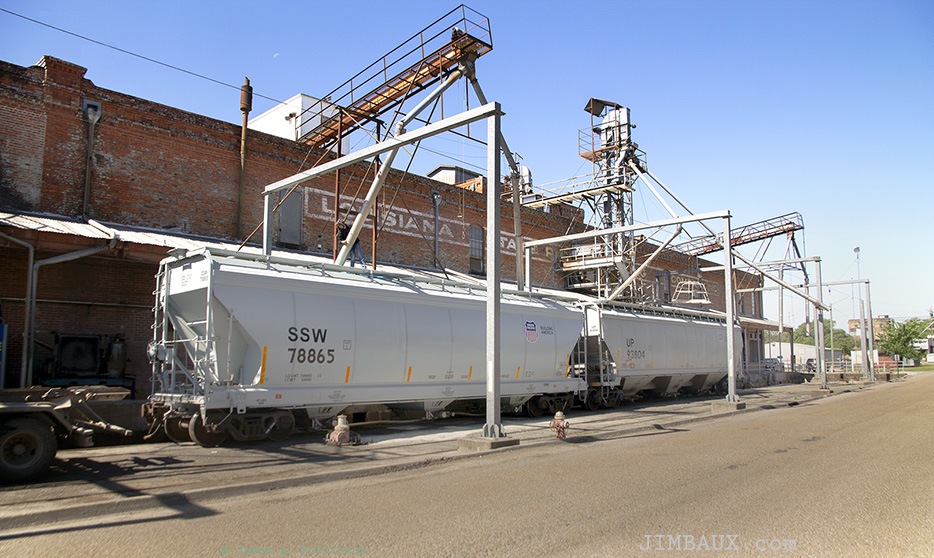
I wish that the loading tracks were on the southern side of the mill, as the lighting would be better, but, really, this is not bad.

Do you see the man atop the SSW 78865, loading rice into it via that chute?

I know that I am being repetitive here (I am my grandmother’s grandson), but I think that the occasion warrants such repetitiveness, don’t you?

Now, the lighting is better for this shot from South State Street.

I really like the array of trackage accentuated with the crossing crossbucks in that image, and the presence of the parked locomotive and cars definitely adds to it.

That white pickup truck back there is annoying, but I think that it’s for a mill employee.
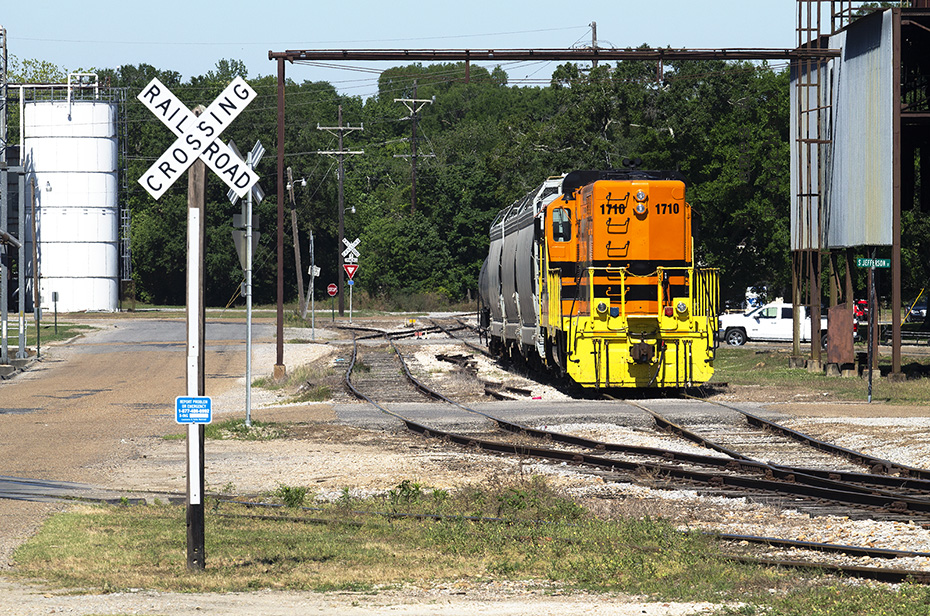
Here is a wider view, showing the two cars at the mill.

I feel sad.

There is still work happening here.

The old brick building in the right background to the north was the old school building and is now part of the administrative complex for the school system.

I know that I am getting repetitive here, but I feel like I should not leave until the SSW 78865 is loaded, given the finality of the event.

This is significant, and I appear to be the only one caring to watch this historic event in the town.
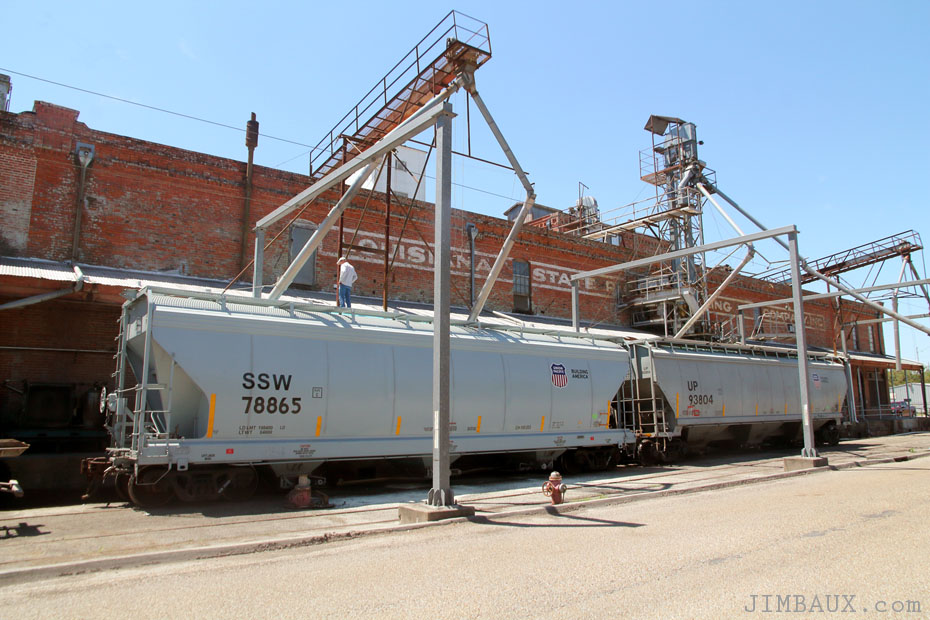
Perhaps, many years from now, people of the town will appreciate my efforts here and enjoy the fruits of my labor, as I have enjoyed the fruits of theirs.

Given the finality of the occasion, there is something angelic about the high sun in this scene.

Afterall, this is April, and it’s really high-sun time, even if it ain’t June.

Well, that’s that, and I should go, though.

After I took the above image, I left the scene, I went back to the homestead.
I would not be there for long at all.
I was hoping to not only eat but also get a needed shower, since, as I said earlier, the intensity of the day yesterday combined with the need to get the above shots this morning left me too tired and too busy for a shower, even though I wasn’t dirty then, but now I really needed one.
At 12:47, I was told that the 12:30 crew was going to Abbeville!
There is no time for a shower!
When my mole let me know that the crew was coming today, I went into the bathroom and hand-washed my face and armpits with warm water out of the faucet and soap. That’s the best that I could do then, and it did help.
I returned to the mill area and had to wait a little while.
At 14:00, a mill employee took that truck used to move the cars and drove it away from the loading area and parked it under the shed, the loading work completed.
Where is the L&D crew?
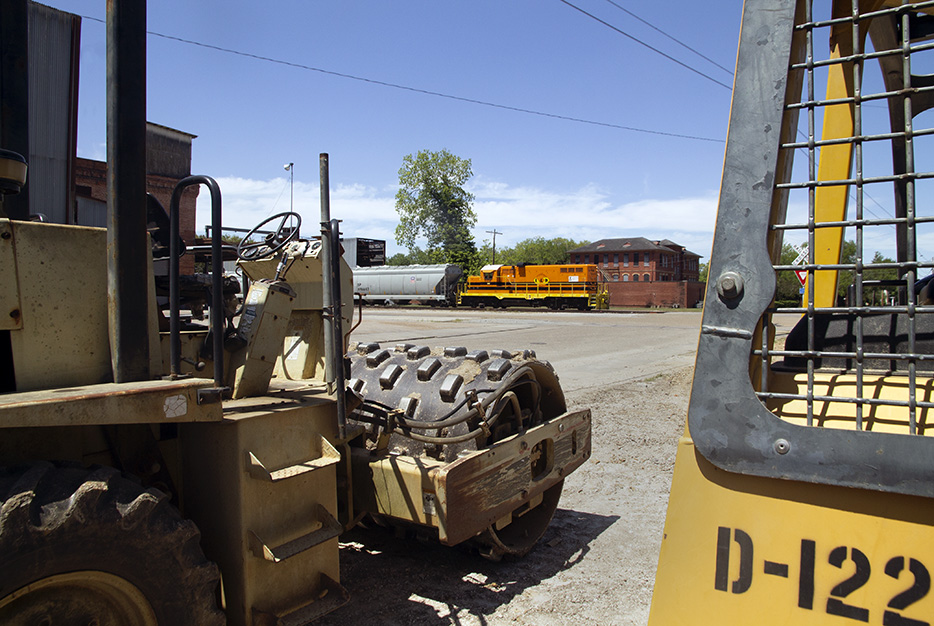
At 14:08, the crew arrived.

You can see the trainman standing on the 1710’s platform, you can see the 1710’s ditch lights on, and you can see the L&D sedan parked more or less in Railroad Avenue.

You can also see that they are about the only sign of still-existing human life in the image.

The mill just looks dead.

Effectively, it is dead.

These scenes are made possible by the recent dismantling of the old, derelict grocery-store structure that was where that open field in the left foreground is.

The 1710 breaks away from the already-pulled-yesterday outbound cars to go past the switch to enter the mill to get the last two outbound cars, and I wonder if any of these people who are witnessing what had been a routine movement of a locomotive at this spot realize the significance of what they are seeing, that this is the last time that it will happen.
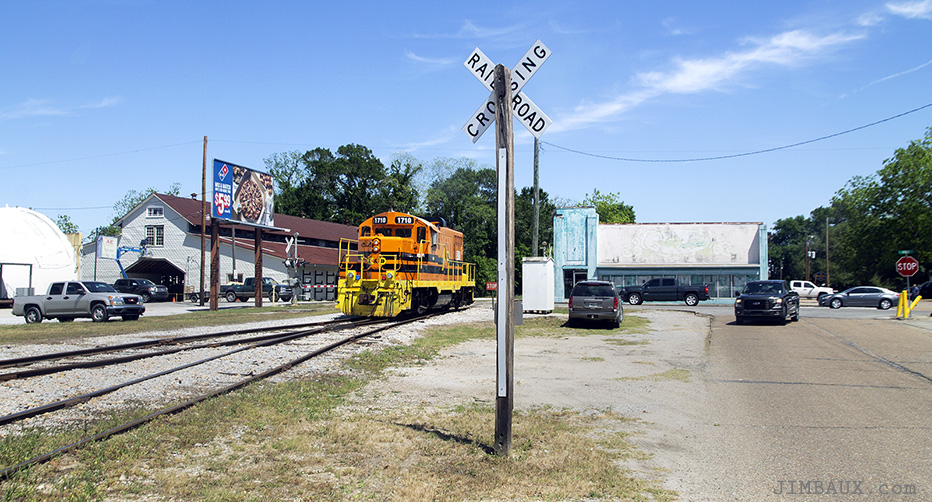
Here comes the 1710, into the mill.
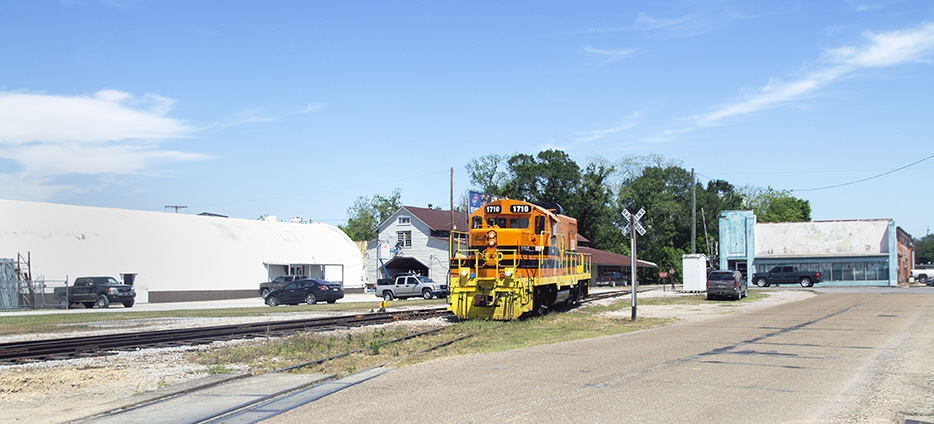
Pickup trucks pulling trailers pass, because there is work to do, but do they care or even know what they are seeing here?

Why am I the only one who cares? Why, God, why?
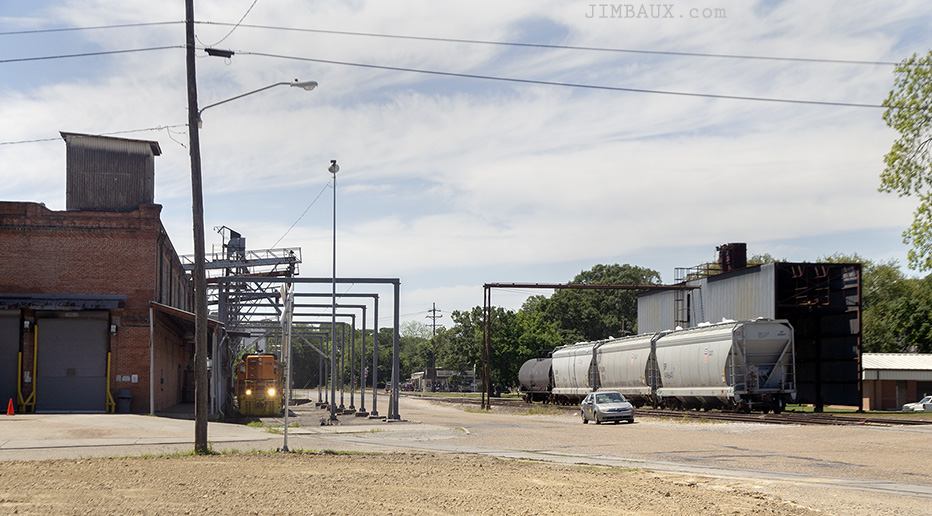
Here it is, the final pulling of cars from the Planters Rice Mill in Abbeville.

It’s simultaneously emotional and anticlimactic.

Just like with the last railroad delivery to Valentine Paper, when Wayne Shell said that it was kind of anticlimactic when the locomotive just dropped off the three boxcars in one spotting and then left, that is similar to how the pickup at the mill today was.

Most personally, for me, with the sadness comes a sense of relief.
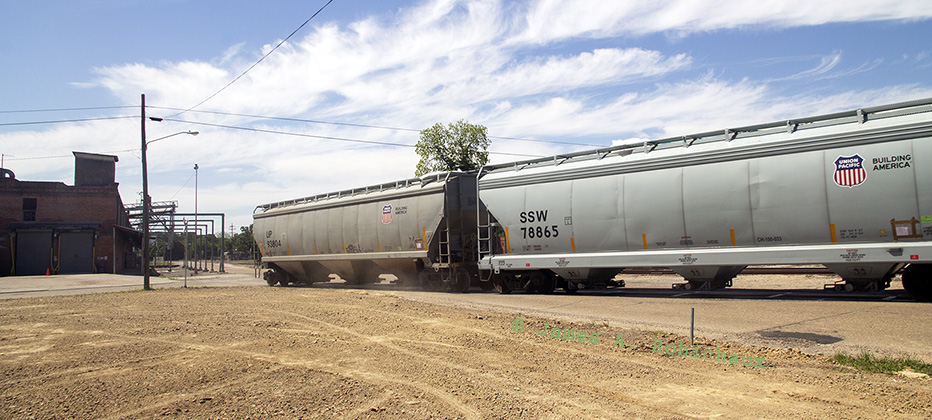
This is really sad, but, for me, the one good thing about trains not coming here anymore is I will get to use that time and energy that I spend on planning my life around the trains and on photographing them and chasing them and on processing the pictures on other things that I have been neglecting. That’s really important!

So, I think about progressive people who say stuff like “that money could have gone to something else” or “those cruise ship industry companies didn’t pay taxes” on other things. Money is infinite, but the time and energy that progressive people had to devote to advancing their causes is not, and they waste precious time and energy on things that ultimately don’t help their cause.

This is like being at a funeral. This really does feel like the Lockport Branch of 12 years ago felt.

The whole train is now built, all six cars.

In a few minutes, there will be no railroad cars in the city of Abbeville, and there may never again be any other cars, except maybe on the train that pulls the rails up behind it.
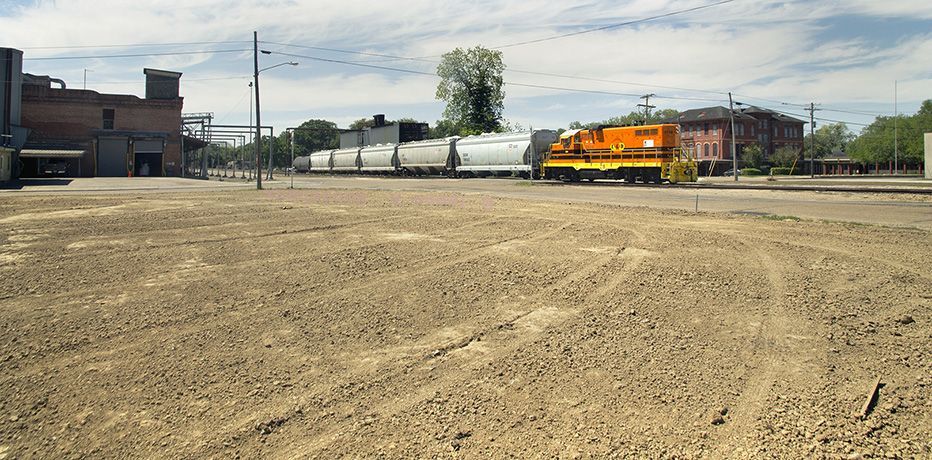
That’s it. That’s the last revenue freight train in downtown Abbeville.
It left.
At 14:38, the train left the downtown area.
I got him at South Lyman Street a few minutes later.

I wonder if the man mowing the grass realizes the significance of what he is seeing.

Three streets to the east, at Schlessinger Street, I was going to again stop in the middle of the road to blast another very quick broadside shot, but I noticed on the southern side of Maude Avenue what appeared to be a father-daughter pair looking intently toward the track, and I didn’t want to foul their view, especially for a lame shot.
I wonder if he just heard the train or if he understood that this was the last run.
So, I went to the next street, Massena Street, and got this view.

I hurried to the Greenbriar shot because, just like yesterday with the inbound train, I really wanted to get that shot.
On the way to the shot, I saw a squirrel shoot out from the trees on the northern side of Greenbriar Lane and dart in front of my eastbound truck. Through my rearview mirror, I saw the body of the squirrel then roll to a stop in the middle of the road. I don’t particularly care for squirrels, but something about the context of this day made the experience of seeing a healthy and vibrant sentient being become a lifeless corpse within about two seconds, and that I was involved in the event, struck me.
Here I was photographing the death of a railroad, motivated, but also antimotivated, by my own sense of my own mortality.
I thought of the song “Snakes” by Papa Roach here for some reason.
Exactly why the squirrel’s death struck me so much still wasn’t clear, but it would soon be.

When you view this set of broadside images from one of my favorite photo locations on the Abbeville Branch and you are considering what went into creating them, note my own effort, my own skill, and my own interests, please, but note, too, that a squirrel gave his life for these images.

I play with the levels on this new version of Photoshop.

This is such a backwards-looking hobby. Death surrounds it. Death defines it. We are so focused on what once was. We are so focused on getting what still is before it dies.
I am magnetically infatuated with this scene because it reminds me of the trains of my early youth, and I want them to return, but they are dead, and, if there is an afterlife, I hope to see those trains, but death surrounds it, I am scared of death and abandonment, including but not limited to this railroad being abandoned (see what I did there?), and a squirrel, who, no doubt, had his own hopes and dreams, lost his life, albeit by his own poor choices, so that I could get these images, but is this a reflection of my own poor choices?
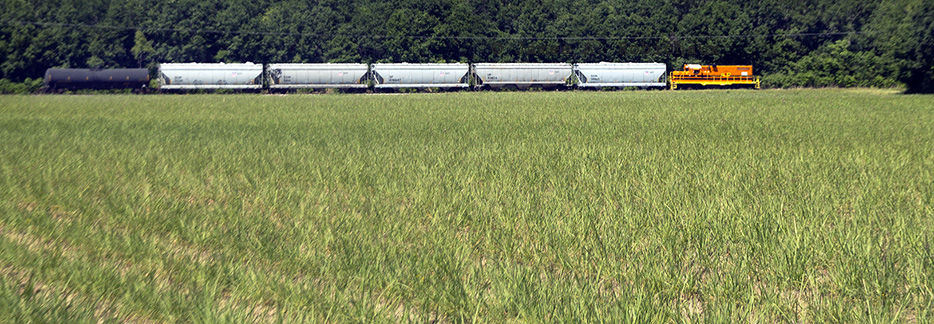
Am I just attracted to things that are about to die? that I cannot have? that are most likely to die?
The train stops at Coastal Chemical.

It set out one tank car, but it did not pick up the other; that means that there are now two tank cars at Coastal Chemical, which means that there will have to be at least one more train here to come and get them, but I don’t expect that that train will go past Coastal Chemical.
Here I am at Sanchez Road on the western fringes of Erath.

This is not bad.

It’s a decently-composed, decently-lit view of the entire train, now that the tank car is not there.

This is someone’s back yard.

I wonder if they, too (or either), care about this train.

I am still thinking of that Patrick Swayze song from the first of the month.

I then got to the other edge of town, the eastern edge of town, at Jude Road, where I got these next two scenes.
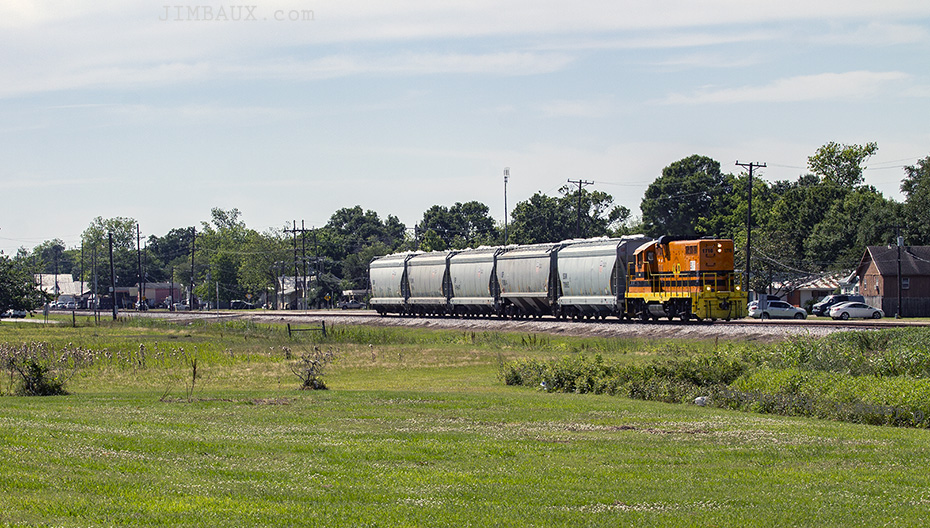
I am satisfied with them.

Next, I got set up by the cemetery in Delcambre, and I had to wait a long time there because, for reasons that I never learned, the train stopped by the carwash place for a while.

Death will not stop being a theme today, will it?

Really, it was right after I left the shot at Jude Road that the title of today’s post came to me. I was thinking about that phrase “everything Trump touches dies” from Rick Wilson, and I thought about how some things that I have touched in various ways, physically, like that squirrel, and photographically, like this railroad branch to Abbeville and like the Lockport Branch, have died, like I am Dale Sanders, former editor of CTC Board magazine, supposedly mortally jinxing the railroads to which I devote serious attention.
I know that that’s wrong, because my attention has no effect on the railroads’ fates, but then I realized that there is something to this, that it’s just that the causal relationship goes in the other direction! It’s that we are attracted to the things that are most likely to soon die, because we are attracted to that “old school” railroad stuff.
It’s like how I am with people in general, how I am both misanthropic and sad at needless suffering of other people, even if I don’t like them. Their deaths touch me.
And, so, I figured it out.
It’s not that everything that I touch dies.
It’s not even that everything that touches me dies.
It’s that everything that dies touches me.

This is not true in an absolute sense, because I don’t know about everything that dies, and I don’t have the capacity or the emotional bandwidth to know, but I understand the old narrative about soldiers in war in the same unit not wanting to get too friendly with each other so as to not be agonized when a comrade in arms dies, and here I am thinking about an unfortunately-foolish squirrel and a railroad operation that is coming to and end.
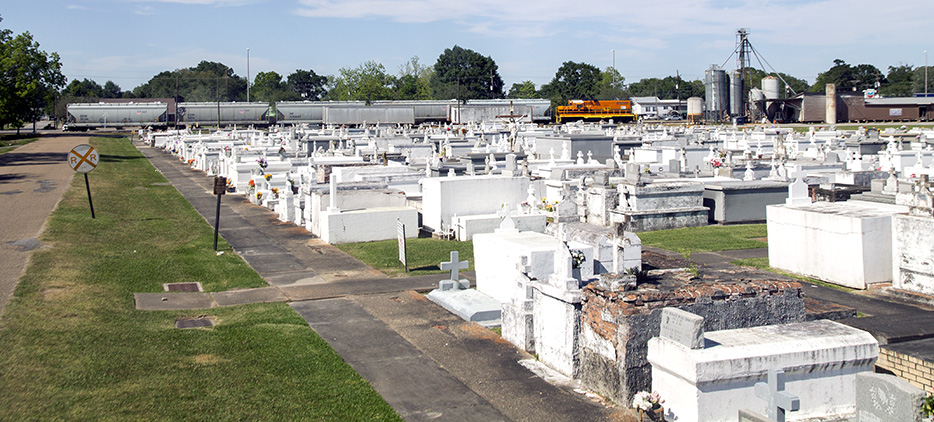
Why, though?

The train and I crossed the Delcambre Canal.

Here is the train sharply crossing Bob Acres Road.

With the sun getting more and more behind the train and with the lack of decent vantages south of the track for several miles, the only thing to do now is go ahead about 5.5 railroad miles to I&V Junction, where the train will turn northward, but that means that I’m going to be on the other side of the train, where that bad graffiti is.
Here is I&V Junction. The carbon black hopper cars are on what remains of the track to Avery Island, which is used for storage, and the Abbeville line is in front of – to the right of – it. You can see the L&D sedan with the trainman waiting, signaling that something more than just the train passing is about to happen here.
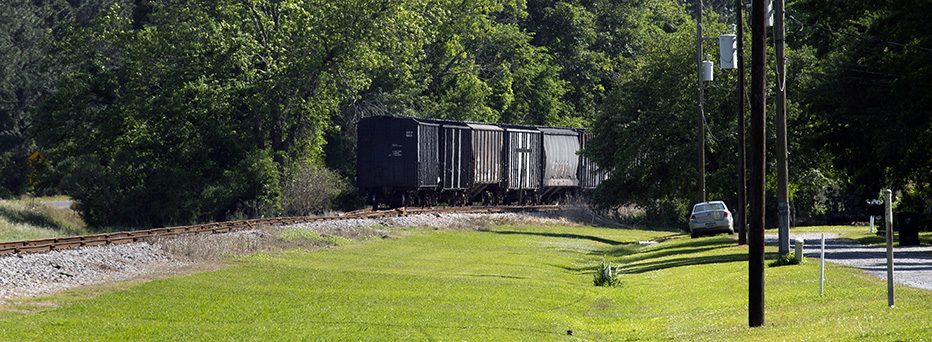
In keeping with the theme of the day, while I was waiting for the train to show up, I learned that Aunt Marie, my maternal grandfather’s last living sister, died yesterday. So, Aunt Marie and Tillie Caileff died on the same day. As I watch the last train from the Planters Rice Mill on the 15th of April in the year Two Thousand Twenty, I am living in a world without Tillie Caileff or Aunt Marie; very soon, very soon, I will be living in a world without Tillie Caileff, Aunt Marie, and trains hauling rice from the Planters Rice Mill in Abbeville.
I am touched.
The train shows up.

I guessed that they were about to do something with those cars in the Avery Island track.

Are they going to drag them, too, to New Iberia? I hope not, since this last train from the Planters Rice Mill will become something else if that happens.

These carbon black cars are empty and are here in storage, mainly awaiting need at the three carbon black plants in Saint Mary Parish that the L&D serves.

Okay, now, we see some tank cars in this cut.

Are we about to get trapped?

Yes, we are!
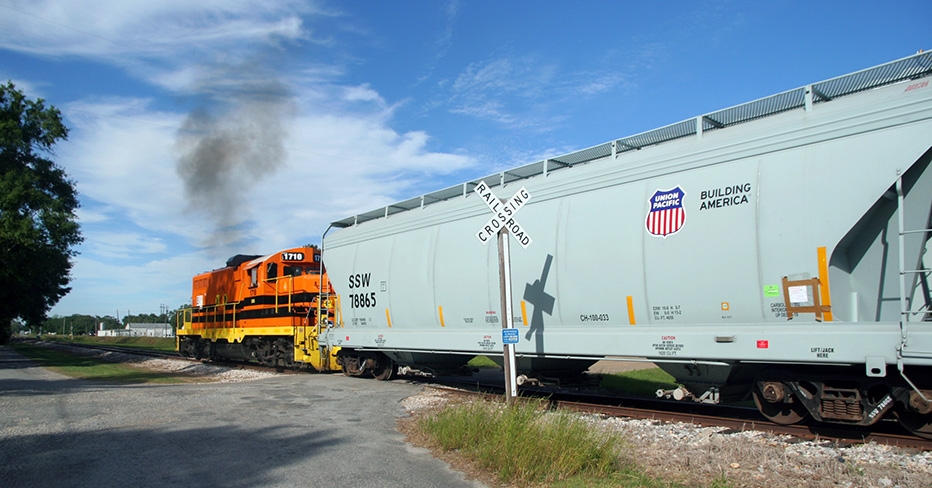
The entrapment did not last long.

Ah, look, they’ve dug out some tank cars and put them on the Abbeville track.

Here is a time to get a self portrait.

So, what was happening here is that these cars, which may have arrived here recently, were just being blocked out.

That means that all of the carbon black cars were put together and all the tank cars were put together.
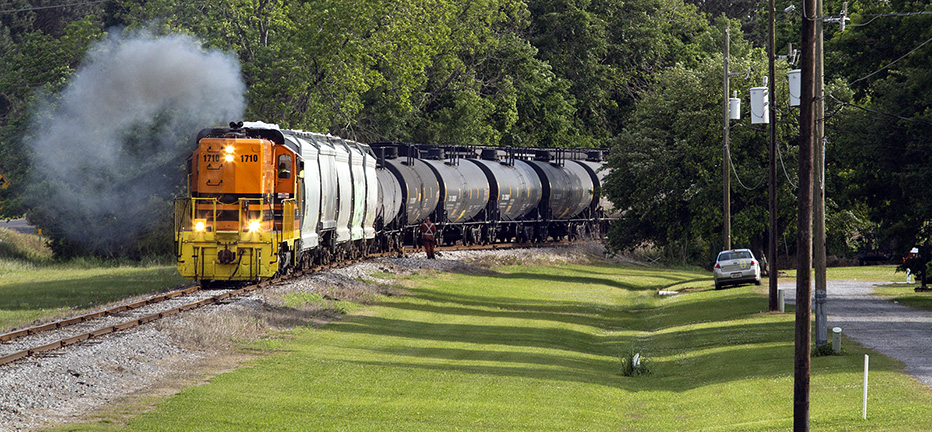
That way, when they are needed, they can be pulled right away, without having to block them out while the customer is actually waiting on them.

And that’s that; our train is now, 90 minutes after arriving here at I&V Junction, resuming its journey to New Iberia.

That was interesting, but I really could have done without it.

Had that blocking out not happened, we wouldn’t be dealing with those shadows creeping onto the train.
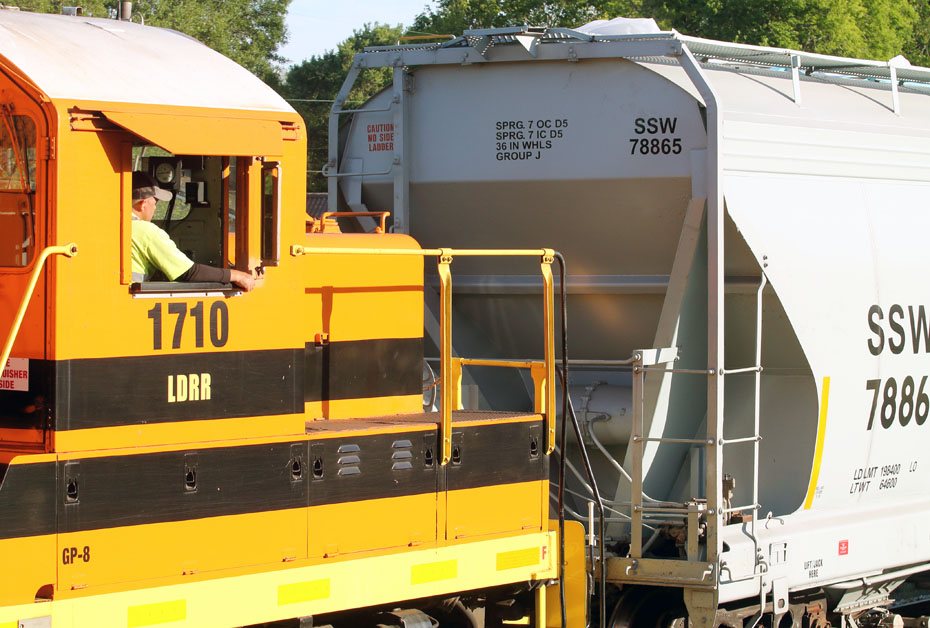
Engineer Josh is at the controls today.

Here are some stored hopper cars on the Pesson Spur, and they are new, too, apparently bought just in time for business to slow down!
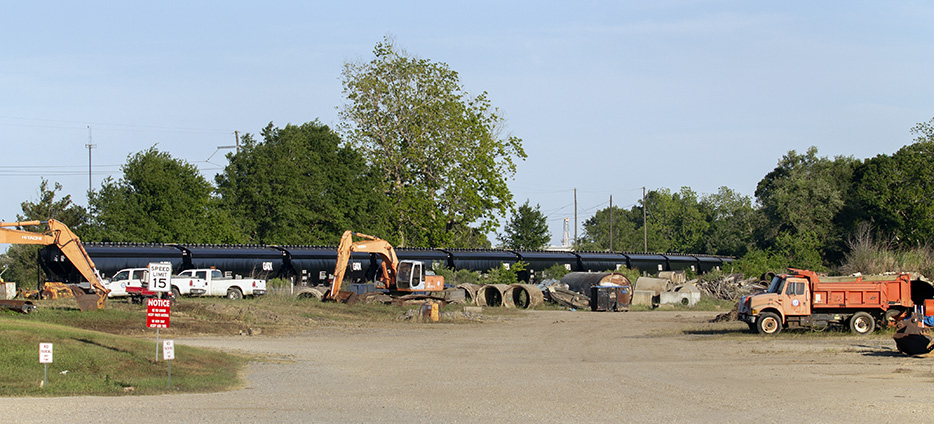
Since it wasn’t overcast, and since there really aren’t shots from the western side of the track here, I just came into New Iberia and set up at a new shot that I had had in mind, a view from West Admiral Doyle Drive.
Before I photographed the train, I looked to the north and photographed the RIP yard and the locomotive shops, where, at center, is what is left of the LDRR 1504 slowly being cannibalized for parts, at left, the LDRR 1500, the last active CF7 on the roster, and, barely visible behind the crossbuck at right, the LDRR 2009, still wearing its Utah Railway paint scheme.

The wait was long, with the train moving at 10 miles per hour, but the train came with the light being rather good for these treed scenes.

I’ve never done this shot before, and, with the rice mill shutting down and with pipe shipments out of the Port Of Iberia being sporadic, I am not likely to ever do it again.
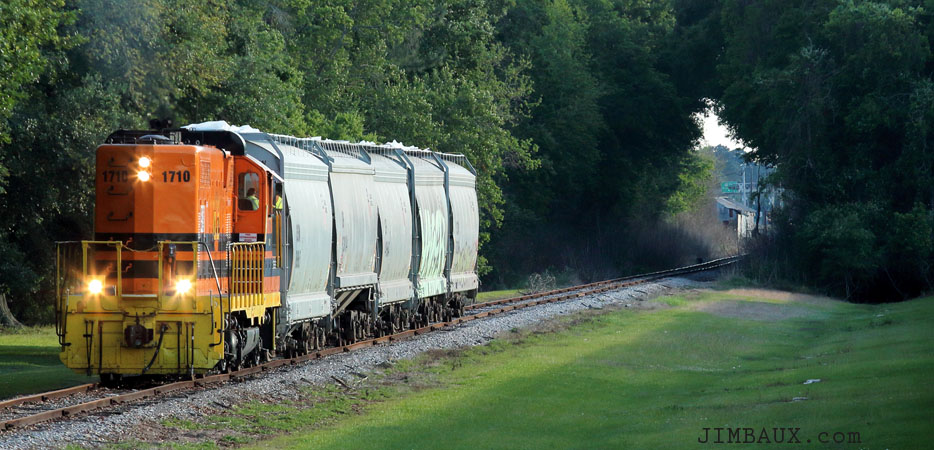
This photo location has so much potential, though, potential that won’t be much realized now.

I like it!
I get set up by the depot, the L&D headquarters, on the mainline, where the branch diverges from the mainline, to get the shot of the last train from the Planters Rice Mill arriving back onto the siding by the depot to go to the interchange yard.

Also, unsurprisingly, that did not happen. As is customary practice, the crew left the train on the branch and brought just the locomotive up, as happened here.

The interchange yard can’t always take cars, and the orientation of the yard and the siding means that a train coming from the east that doesn’t have a locomotive on the end of it has to foul the mainline at the west siding switch in order to get the cars into the yard.
Speaking of the west siding switch, it’s already occupied right now anyway, as the Union Pacific Railroad’s local train, the New Iberia Turn, which conducts all UP interchange with L&D here in New Iberia and at Schriever or Raceland, arrives with 11 cars, which is why the train off of the Abbeville Branch couldn’t have come here right now even if it wanted to do so, and it was about knock-off time for the L&D crew anyway.

It looks like the UP 816 has a damaged numberboard.

It looks like the engineer is realigning the switch back for the mainline.

That van in the left background is the crew taxi to pick up this crew, presumably to take the members to a hotel.
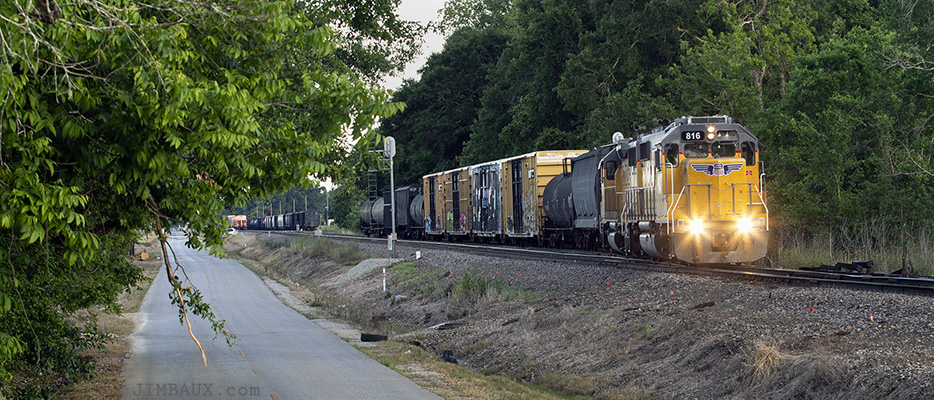
I like this view, and I like this train, even if it is not carrying any cars bound for the rice mill.

This is the first train that isn’t an L&D train that I see in a month and a half; the last time that I saw a train that wasn’t an L&D train was the last time that I went to New Orleans or anywhere east of New Iberia, on February 29.
Anyway, apparently, some horses took an interest in me photographing, from a top my truck, the UP local train.

Well, that’s done, and I am really hungry and really think that I’ve earned some splurging. This train-chasing stuff is like hunting, and gorging on something after a big chase always seems appropriate, even if it isn’t.
So, on my way to grab something, I stopped at the L&D locomotive shops on Saint Mary Street.

Here, we get better views of the LDRR 2009, still in its Utah Railway paint even though it has been on the L&D property for well over a decade now, and the LDRR 1500, the last active CF7 on the L&D roster, the last of the locomotives of my childhood still on the roster, and I am so sad to see it in such a state.

I got a Caniac combo from the Raising Cane’s, the first fast food that I have had since the start of this pandemic, and the Raising Cane’s in New Iberia had, to my delight, a touchless transaction set up, with the window clerk at the drive-thru handing out a card reader, asking me, the customer, to stick my card in there myself.
I returned to West End Park to eat my food and peace and see and hear any railroad action there.

So ends a very memorable and emotional day.

Remember, it’s not that everything that I touch dies (that’s Trump), and it’s not even that everything that touches me dies; it’s that everything that dies touches me.
So it is with the death of trains to and from the Planters Rice Mill in Abbeville.
Peace.
Jim


{ 1 comment… read it below or add one }
These are brilliant, as are all your other posts. Thanks for sharing them !!!!